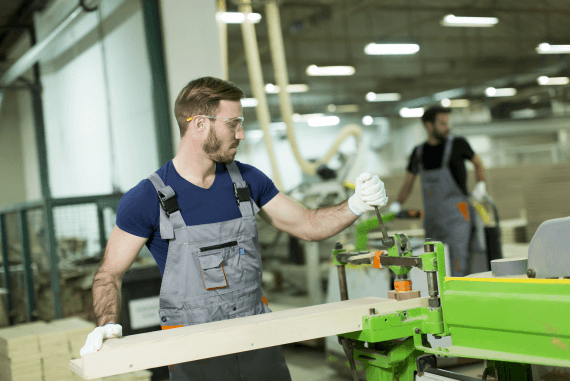- Home ››
- Health and Safety Training ››
- Manual Handling Training ›› Manual Handling - Stand Rather Than Sit?
Manual Handling - Stand Rather Than Sit?
Workplaces Can Be Very Different To Each Other

The workplaces of different industries will vary tremendously. For instance, workers on a demolition site will have a very different working environment than those working in a care home. This contrasting environment also means employees operating in each will face quite different health and safety dangers, and yet some will also be similar.
The manual handling of loads is one such threat to safety which is common to not only these two industries, but in fact every place of work on the planet. Having to move an object from one place to another is a task which we can often take for granted and start without really thinking about it, but all too often in can result in an injury if we overexert ourselves or continue sitting when we really should stand up and position our bodies properly for a lift.
Being Uncomfortable Often Means a Strain on the Body
Comfort in the workplace is not just about making employees happy and contented at work; it also has a direct bearing upon their health and wellbeing, insofar as being uncomfortable usually means that there is a strain upon a part of the worker's body. As most people's work day lasts quite a few hours, the strain over this lengthy period of time will more often than not lead to an injury occurring which ultimately can keep them off work - and severely impact their personal life - for many weeks or months to come whilst it heals.
The dangers of poor manual handling techniques typically go hand in hand with the risks posed through repetitive strain injury (RSI). Quite often, the combination of manipulating an object in an awkward or uncomfortable position many times over is a perfect storm for an injury to the body; one which can take a long time to heal fully. This is why it is imperative that as soon as you begin to realise that you are uncomfortable, you should stop immediately and correct the situation before any major damage is done.
However, it can also be the case that just one instance of moving something which is awkward in size, too heavy for you, or you were just a bit too lazy to stand up and move it properly (see below), can cause an manual handling injury like a strain, sprain or muscle tear for example. This is why it is so important to lift objects correctly each and every time, even if this does mean getting up from your chair and standing up to do it!
Sit Down or Stand Up?
A lot of workers will initially request a seat and sit down at their workstation to do their job. However it may be the case that sitting down requires them to stretch awkwardly to reach something, or try and lift an object whilst sat down, which puts a lot of pressure on their spine as they lean over. In this situation the worker may actually be more comfortable and be less likely to suffer an injury by standing at their workstation rather than sitting down. Even so, it is important that they take regular breaks and sit down, or if possible, sit down in between those tasks which require them to stand.
The ergonomics and design of an employee's workstation and their working area is an important factor for managers to consider, particularly when moving into a new building or re-arranging the layout of an existing work space, and should form part of a comprehensive risk assessment. Along with manual handling training and health and safety courses, the design of the workspace can have a significant impact upon the likelihood of workers suffering manual handling injuries, as the less distance they need to move objects the lower the probability of an injury.
How Technology Can Help With Manual Handling
Before the introduction of machines and mechanical equipment, heavy lifting was performed with the assistance of animals or, quite often, through good old fashioned brute strength. Obviously, when people were having to transport loads which were extremely heavy and/or awkward, cases of manual handling injuries were therefore extremely high.
The invention of mechanical aids and new materials not only means far heavier loads can now be lifted and moved about with ease, but it also takes a lot of pressure of the bodies of workers who might otherwise have had to shoulder the whole burden themselves.
Making use of machinery and equipment to assist with moving objects, in conjunction with thorough manual handling training, will go a long way in preventing injuries caused by poor manual handling in the workplace.
Why is Manual Handling Training Needed?
Whilst it may all sound like common sense or even quite patronising, the concept of telling people how to lift or move an object, it will come as a surprise how must people actually fail to perform an action such as lifting a heavy item with the correct posture. Even though they may get away with doing this many times, it only takes one incident when the body is pushed a little too far and they could be off work for a long time, not to mention in serious pain and discomfort.
Manual handling training is therefore an essential part of a firm’s health and safety training provision to its workforce.
Both managers and employees have a responsibility for health and safety in the workplace, and this includes manual handling. Not only do managers need to provide suitable manual handling training for their employees, in order to give them the information they need to prevent injuries to themselves, but workers too have a responsibility to implement what is taught and be mindful of the risks to their health that can be caused through poor manual handling practices.


